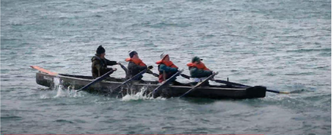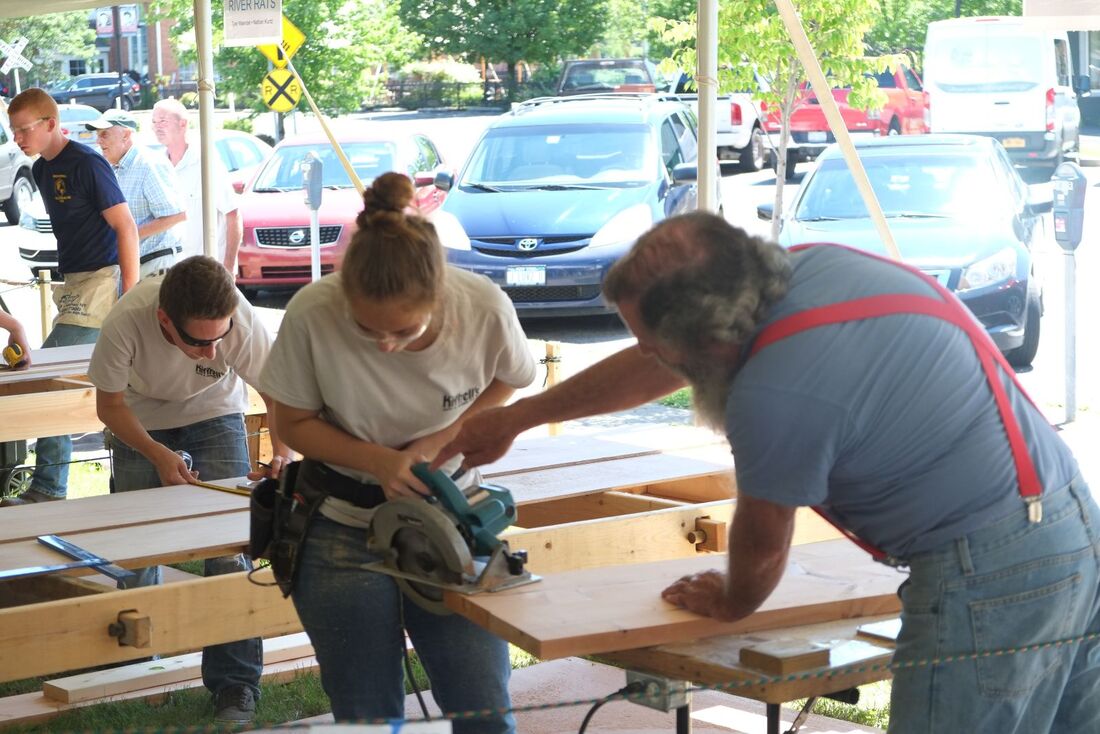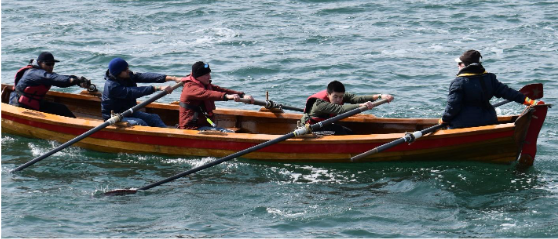|
We are thrilled to be hosting the 2022 Kingston Boat Building Challenge again this year! As part of the Hudson River Maritime Museum’s semi-annual Celebration of Woodworking Festival, woodworking adult and youth teams will compete to build rowing boats in a single afternoon. This event takes place October 1st, 2022, on the Kingston waterfront. And we want YOU to join us in the competition! In 2017, the Hudson River Maritime Museum hosted its first annual National Boatbuilding Challenge, where teams of two compete to build a boat from scratch in just four hours, and then compete in a rowing race on the Rondout with cash prizes for the team with the best score in all three categories: speed, quality, and rowing race. HRMM's event is a qualifying challenge, one of just a few competitions around the country. Held only on Saturday, October 1, this thrilling competition draws national and local competitors alike and the 4:00 PM rowing race is the highlight of Saturday's events. Competitors are invited and encourage to watch professional builders build the entire boat from start to finish to observe tips and tricks on our pre-competition demonstration day Saturday, September 3rd. Entry Fee is $250; each team will receive which $500 worth of material from HRMM. Teams must provide their own tools.
You can see example of past boat builders challenges here: https://youtu.be/uDqQWWeSizU Judge's Meeting - 9:30 AM Builder's Meeting - 10:00 AM Challenge Begins - 11:00 AM Challenge Ends - 3:00 PM Judging of Boats for Quality - 3:15 PM Rowing Relay Race - 4:00 PM Awards Ceremony - 5:00 PM
0 Comments
The 41st Annual Snow Row at Hull, MAMarch 5, 2022, Hull, Massachusetts By Nelsie Aybar-Grau Nelsie will be presenting a lecture on Wednesday, April 27th, 2022 "Why I Love Rowing" Two years ago I booked myself a room at the Nantasket Beach Hotel so that I could attend the 41st Annual Snow Row in Hull, Massachusetts. I had just finished creating a one and a half hour PowerPoint called Waterways, Rowing and Regattas and in it I had included the 2016 Youtube drone video showing the Snow Row organized by the Hull Lifesaving Museum (HLM) in Hull, MA. Little did I know what would happen on the day that event was to have taken place. The race was cancelled due to COVID19 and I lost my hotel money. Even worse, the race did not take place until two years later on March 5th, 2022! Well, I finally got to attend and learned so much more about rowing than I knew when I made that PowerPoint two years ago.  Ed McCabe helping move boats to the start line Ed McCabe helping move boats to the start line The Venue You would not expect the lovely, tiny town of Hull, MA, population 10,293, to host the most phenomenal rowing event. About half an hour away from Boston, MA, population 684,379, this event draws participants from as far away as Manhattan, New York, and all the way up to Belfast, Maine! The Snow Row is the idea of HLM which was founded in 1978. It has two fleets of boats, one at Windmill Point boathouse on the Hull peninsula (two pilot gigs and four Whitehalls) and another at the Boston Rowing Center on Fort Point Channel, (two pilot gigs and three Whitehalls). Because of this they have a robust open water rowing program. They even built four of the Whitehalls and two pilot gigs. Forty one years! That’s a lot of years, folks. You have to applaud a community that can pull off an event of this scope for such a length of time. Starting from a group of friends rowing their own boats to now a fleet of 11 boats! Kudos to the museum staff and volunteers but especially Ed McCabe, the only remaining founder who I saw there at the crack of dawn to help participants move their boats.  The Race Although the actual race start was at noon I got up before dawn to catch the sun rising on the Atlantic Ocean. It “felt like” 17 degrees but the sunrise on the spectacular 3 mile Nantasket Beach was well worth the braving the cold. Sadly there was no snow! It had snowed the week before a bit and I remember that in 2020 when I would have gone it would have been snowing. Nevertheless my crew and I were excited to be there finally and at 8:30 am we made it over to Windmill Point on the tip of the peninsula to see the rowers arrive and set up their boats along the narrow beach.  Women rowers in a pilot gig (six oars) Women rowers in a pilot gig (six oars) The Snow Row venue I have been to many “crew” rowing events like the Head of the Charles in Boston, the Dad Vail in Philadelphia and numerous scholastic division races in Poughkeepsie, near my home in Kingston, New York. In those races the spectators were friends of the rowers who were mostly either in high school or college rowing programs and their parents and, maybe, grandparents. Here, although some rowers were youngsters, the lion’s share were masters, i.e., parents, grandparents, empty nesters, retirees, seniors…you know what I mean? These frisky folks did not balk at an early rise or sub-freezing temperatures---they were bundled up and ready for anything!  Moving a pilot gig to the start line Moving a pilot gig to the start line Their enthusiasm was infectious, and we would soon find ourselves lending a hand in the jockeying of boats on the start line. A half an hour before the noon start there was a swarm of people all over the beach and the spectator boat Massachusetts had over a hundred and twenty-five people packed into the stern clicking away with their cameras and cell phones as they waited for the announcer to count down the seconds to the start. The 219 registered rowers were in a state of heightened alert. The start is on the narrow stretch of beach sand around 390 feet wide southeast of the Windmill at the end of the Hull peninsula. I noticed the length because it reminded me of the beach where I launch at Kingston Point, which is about 420 ft wide. The first wave (there were three) of the 3.75-mile race would start with a horn blast and mad dash, Le Mans style, to the boats. Once there the crew members would back out (stern first) because the on-water launch means your rudder has to be submerged deep enough to prevent its damage. Then backpedaling (rowing) and turning the boats around made for chaotic splashing, sometimes clashing, of boats and oars until each vessel broke away for the dash to Sheep Island in Hingham Bay where they would turn and head back, around the day marker, and on to the finish. After 50 minutes most of the gig boats had returned but not until an hour and 23 minutes had passed would the last rower make it back to the beach. Then, of course, a party to celebrate before the long hall home (surprisingly both Belfast, ME, Kingston, NY and New York City are all about 4 ½ hours away). Boats, boats, boats !!! Boats. The sauce that makes this regatta so exceptional (besides the very friendly, adventuresome people you meet at these events)! The boats! Call them “traditional” or “classic” boats they are replicas built mostly by not-for-profit organizations. Some are made of wood and many use wooden oars also made by the same organizations. There are too many to cover in this piece but the four largest and most numerous where the Pilot Gigs, Whaling Boats, Whitehalls (or coxed 4), and the Currachs. Pilot Gigs The greatest number of race entries were the Pilot Gigs (I counted 14 on the race results page). Originating in Cornwall in the southern part of England pilot gigs were built for speed, endurance, and stability in rough seas. They are a hefty 32-feet long and about 4 feet 10 inches wide (built to a detailed specification from wood). Manned by six rowers and a coxswain they are heavy and imposing.  The pilot gig Kittery The pilot gig Kittery The HLM rowed a pilot gig in the race, the Kittery, built by rowers in Kittery, ME. It was coxed by Judy Flaherty.  the pilot gig Norumbega the pilot gig Norumbega Another interesting pilot gig was Norumbega which belongs to Muriel Curtis. Muriel is the author of Come to Oars: Experiential Education on the Coast of Maine. And she runs StationMaine.org which teaches maritime skills such as sailing and rowing at no cost to young participants.  the pilot gig Mad Martha the pilot gig Mad Martha The Mad Martha (don’t you love the names!) belongs to the Massachusetts Bay Open Water Rowing Club out of Plymouth Harbor, MA. This club has 5 gigs and welcomes newbies.  the pilot gig Belle Fast the pilot gig Belle Fast I want to mention Belle Fast and Selkie, pilot gigs hailing from Belfast, ME of course! They belong to the club Come Boating Belle Fast Maine. This club lists programs in sailing, rowing, youth rowing, pilot gig rowing, winter rowing and coxswain training. Whaling Boats! Although there were only three in the whaling boat category (the Skylark, the Flying Fish, and the Herman Melville), I have to say they blew me away. It is not something I had ever seen. All of the entries were from the Whaling City Rowing Club that rows off of Pope Island Marina in New Bedford, MA. In 1997 a group of people calling themselves "Whaleboats for the Whaling City" under the auspices of the Waterfront Historic Area League (WHALE) raised over $60,000 to build the three Beetle whaleboat replicas that are now used by the Whaling City Rowing Club. They are 28 ft long with a 6 ft beam. They weigh about 1000 lbs. empty. They require five rowers plus a coxswain. The coxswain stands at the stern and manages a long oar attached there. Three rowers on the starboard side and two rowers on the port side propel the boat forward. These boats remind me of the Spanish traineras that have a cox that stands at the stern of a 40 foot long boat with 13 rowers. Such boats are the norm in the Bay of Biscay up near France. Rowing in a trainera is at the top of my bucket list but now so is whaleboat rowing!  a whaling boat showing three starboard oars and two port oars a whaling boat showing three starboard oars and two port oars Whitehalls I am very familiar with the Whitehall as I have rowed the John Magnus, owned by the Hudson River Maritime Museum in Kingston, NY AND the Pete Seeger built and owned by the Village Community Boathouse (VCB) in New York City. The Whitehall was used as a rowing workboat in Boston, New York City, and, later, in San Francisco and likely evolved from the English Wherry. It is about 26 feet in length and carries four rowers and a coxswain. Balanced and swift it is the perfect boat for racing around any harbor. I believe there were seven Whitehalls in the Snow Row. They are mostly referred to as “coxed 4”s on the HLM race results page . The HLM Whitehall “Sacred Cod”, built by students in summer job training programs. Coxed by Corinne Leung, Director of Advancement & Communication at the HLM, the Sacred Cod has a cutout of a cod fish at the bow instead of the words “Sacred Cod”. It’s the only boat that has that distinction. HLM entries “Rescue”, coxed by Noel Blumenthal, and “Nobel”, coxed by Mike McGurl, executive director of the HLM, I was told are Whitehall loaners from VCB. Village Community Boathouse (VCB) entered two boats, a dory and a Whitehall. The Whitehall “Notorious GIG” was coxed by Dave Clayton. I must point out that not only does VCB have a wonderful rowing enterprise (their fleet consists of a total of 32 boats), youth programs built many of the Whitehalls in their eleven gig fleet. And they recently gifted a Whitehall, the “GML”, to the StationMaine.org in Rockland, Maine because they have too many boats AND because StationMaine.org is dedicated to offering boating opportunities at no cost to youth of all ages in the mid-coast Maine area. The Currachs or Curraghs Then there were I believe three Irish currach boat clubs. After asking around a bit I realized that the boats called “livery hov” boats are actually currachs. Anyway, these wooden boats sport four rowers without a coxswain (a 4- in crew parlance) and their oars look like, well, 2 by 4s. The oars attach to the boat with a triangular wooden piece. I found two clubs that entered the Snow Row with the currach: The Boston Currach Rowing Club and the Albany Irish Rowing Club. Both are members of the NACA, North American Currach Association which hosts regattas for currach clubs all over the nation. I never knew any of this! We were able to get a video of the Albany Irish Rowing Club as they launched their boat into the water. This is the clip https://youtu.be/JWCwa53jw98 . Since this club is only about an hour away from me I intend on rowing with them very soon!  Rowers from the Albany Irish Rowing Club Rowers from the Albany Irish Rowing Club Get involved, no experience required! Finally I want to add that there were two other museums besides the Hull Lifesaving Museum that participated directly or indirectly in this event: the Cape Cod Maritime Museum and the Lake Champlain Maritime Museum. Most of these organizations welcome new people and would not mind letting you join a row if you contact them beforehand. I encourage you to do so. I plan to return to the HLM to row with them on a less hectic day than the high energy regatta that is the annual SNOW ROW. But I would love to row a currach and a whaleboat, so those two items jumped into my now very busy bucket list. And I look forward to telling you all about it! Have you ever wanted to learn to row, but were intimidated by the long, narrow rowing shells? Consider learning traditional rowing in a historic style boat like a Whitehall gig! Rowing instructor Nelsie Aybar-Grau can tell you more: Excerpt from My Row Around Manhattan, September 11, 2021 By Nelsie Aybar-Grau In the early nineteenth century, Whitehall rowboats were the choice of crimps (who would entrap men to work in shipping), boarding house runners (men who persuade sailors to leave a ship for better jobs that never materialize), and of anyone who required reliable and speedy transportation from one part of the harbor to another – pilots, ship’s crews, brokers, ship chandlers, newspaper reporters, insurance agents, doctors, police and many others. I have been rowing for 12 years, give or take. I row the Rondout Creek and Hudson River from Kingston, New York. I learned to row crew boats (the long, skinny, carbon fiber boats) with the Rondout Rowing Club. I was the president of the club for four years (2014 - 2017). The club would do an annual excursion from Kingston to Norrie Point, south of the Esopus Lighthouse and back. There we would meet up with rowers from the Mid-Hudson Rowing Association of Poughkeepsie. A few years ago the Hudson River Maritime Museum asked me to teach rowing to teens who were participating in the museum’s YouthBoat Project. While learning woodworking they were given the opportunity to row a Whitehall in the Rondout Creek. Most had never been on the water, and some did not know how to swim. But within minutes many got the hang of rowing and because, as cox I could compensate for those unable to keep up, we still managed to navigate the creek reasonably well. That is when I realized that the Whitehall is probably the best boat to use to teach anyone how to row. It is perfect for beginners and pros alike. For more of Nelsie's adventure, keep reading... Want to Learn to Row?Enjoy the historic Rondout Creek the way our ancestors did. Rowing has been pivotal to all working waterfronts for as long as people have taken to the water. Only last century was rowing replaced with motors as the main way to move people and goods around harbors and ports. Join us as we return to this tradition with a fun row on the creek. The museum's Rowing School offers several evening and afternoon classes in traditional rowing Did you know? HRMM members get discounts on all classes! Join today. Interested in learning more? Check out some of the classes and programs we offer below, for all ages and all experience levels.
|
AuthorStaff and volunteers of the Hudson River Maritime Museum's Wooden Boat School and Sailing & Rowing School. Archives
August 2023
Categories
All
|
|
GET IN TOUCH
Hudson River Maritime Museum
50 Rondout Landing Kingston, NY 12401 845-338-0071 [email protected] Contact Us |
GET INVOLVED |
stay connected |
Proudly powered by Weebly











 RSS Feed
RSS Feed